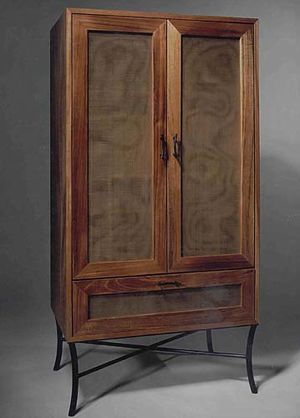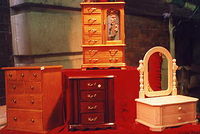Wardrobe
- You may be looking for The Closet and not even know it!
| Wardrobe | |
|---|---|
A North American Red-Breasted Wardrobe (Wardrobiae Americanus). | |
| Scientific classification | |
| Kingdom | Animalia |
| Phylum | Housa |
| Class | Furnituria |
| Order | Dooriformes |
| Family | Woodii |
| Genus | Wardrobiae |
A wardrobe is a horrible creature of yore known for inhabiting the attics of old professors' homes, eating small children, and causing those around it to believe they are in a fantastic land fraught with peril, an effect thought to be caused by the mushrooms that grow within its body cavity.
Anatomy and biology[edit | edit source]
Wardrobes evolved[1] from a giant subspecies of prehistoric creatures known as "cupboards" (Cupboardus maximus), which in turn had evolved from "shelves" (Shelfus flatboardius). Nowadays, both these creatures are extinct. The last reported sighting of a shelf occurred outside Fort Worth, Texas on January 17th, 1953.
Wardrobes belong to the wardrobiae genus, so they tend to have a squarish body structure that encompasses a large body cavity that may be filled with "huffable" mushrooms and odd ridges lined with the items the wardrobe has collected through suction and during its travels.
Because cupboards and shelves are extinct, they are considered dinosaurs, as are wardrobes.
History[edit | edit source]
Discovery[edit | edit source]
When adventurer Parco Molo set out on his epic quest to find, name, and kill every species of animal he encountered on his journey, he never expected to find such a terrible beast as the wardrobe. The local tribesmen had told Molo of such a creature they called oko-toko-poncho, or "he who is always hard like wood", though at the time, he dismissed the thought of a seven-foot high behemoth that is always hard as a mere legend.
But all his presumptions had been shattered three days later, when he encountered a live wardrobe in the heart of the Canadian wilderness. He described the experience as such in his diary:
"Dear Diary, today I found the like, the most totally spooky thing in the forest. I guess those natives were right, oko-toko-whatever is so totally real. The thing looked like a closet, only it like, walked around and wasn't like, stuck to the wall and stuff. Anyway, it attacked my team, and so I had to fight it, and I did, using my mondo bo staff skills, and it like, ran away."
A week later when Marco Polo returned from his trip, as well as finding the new form of mints called polo's, he helped design a way of capturing these wardrobes. He was the first person to lay eyes on one of these magnificant creatures. he kept writing stories all about wardrobes like The Lion, The Witch and The Wardrobe but later suffered a wardrobe related desease and died two weeks earlier.
Public doubt and fascination[edit | edit source]
When rumors surfaced of a 200-pound giant that is always hard stalking the jungles of Canada, people had different reactions. Some met Molo's accounts with skepticism, claiming that no such creature exists and that Molo had simply gotten high with the tribespeople and hallucinated. Still, a number of expeditions were carried out into the Canadian wilderness and other adjoining lands to track down this legendary beast. Among the naturalists to find evidence for the existence of the wardrobe was Nigel Thornberry, who brought back a sample of the creature's flesh, proclaiming: "Indeed, the meat is always hard."
The Battle of Drobe-Flux Creek[edit | edit source]
It has become clear in recent years that wardrobes are becoming the biggest threat to the Western hemisphere since Eminem. With more and more wardrobes leaving the hustle-and-bustle of jungle life to find peace in the quiet tranquility of countrysides and old men's attics, there are few places humans can call home without having to share with the constantly hard beasts. At first they were simply a nuisance, but as time passed, it became obvious that something had to be done when one wardrobe managed to suck up the entire town of Omaha, Nebraska, though it was not realized until three months after the actual incident because nobody cares about Omaha, Nebraska.
Fearing for their lives, America, Canada, Mexico, and The Land Before Time joined forces to stop the wardrobe menace before it became too late. Together, they built (well, the Mexicans mostly built it) the Drobe-Flux Generator, a machine which delivered a subsonic frequency to draw all wardrobes into its three-mile radius. Once the wardrobes were in range, Phase 2 was to be carried out. Armed with a small militia, the Canadians were to shoot flaming arrows at the coming swarm while the Americans enjoyed a fresh cup of Maxwell House, and the Land-Before-Time-ians still attempted to catch up with the Mexicans.
But it did not go as planned. While the wardrobes suffered fewer than 14 casualties, the Americans (and those other guys) lost 50,000 (and about 970,000,000 of the other assorted nationalities). In the end, the Battle of Drobe-Flux Creek was a disaster, but it did get rid of those annoying Canadians once and for all.
Conservation[edit | edit source]
Currently, wardrobes are protected by federal and state authorities, due to the drastic decline in population over the last half of the 20th century. Some blame this decline on the encroachment of the wardrobes' natural habitat by humans to build their hospitals, schools, orphanages, etc. Some blame Conservatives and hippie recyclers who reuse old wardrobe flesh as firewood. But most just blame those radical Liberals, with their non-traditional storage solutions. It is also possible that the Illuminati, in cooperation with the MIB have been hunting down wild populations of wardrobes and attempting to eliminate them for unknown reasons.
See also[edit | edit source]
Notes[edit | edit source]
- ↑ If you believe in all that Charles Darwiny evolutionary stuff, that is







